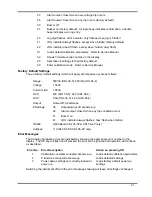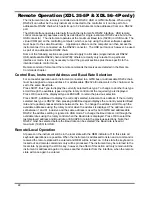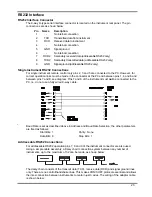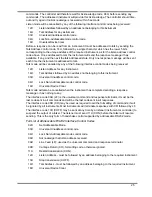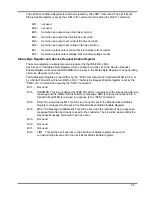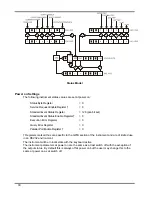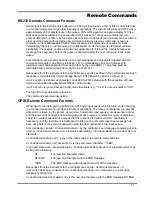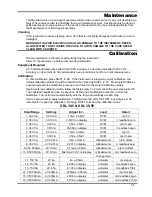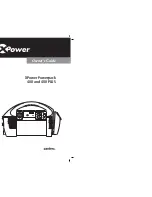
System and Status Commands
*RST
Resets the instrument to the factory default settings
−
(see Factory Defaults section) with
the exception of all remote interface settings.
EER?
Query and clear Execution Error Register. The response format is nr1<rmt>.
QER?
Query and clear Query Error Register. The response format is nr1<rmt>
*CLS
Clear Status. Clears the Standard Event Status Register, Query Error Register and
Execution Error Register. This indirectly clears the Status Byte Register.
*ESE <nrf>
Set the Standard Event Status Enable Register to the value of <nrf>.
*ESE?
Returns the value in the Standard Event Status Enable Register in <nr1> numeric format.
The syntax of the response is <nr1><rmt>
*ESR?
Returns the value in the Standard Event Status Register in <nr1> numeric format. The
register is then cleared. The syntax of the response is <nr1><rmt>
*IST?
Returns
ist
local message as defined by IEEE Std. 488.2. The syntax of the response is
0<rmt>, if the local message is false, or 1<rmt>, if the local message is true.
*OPC
Sets the Operation Complete bit (bit 0) in the Standard Event Status Register.
This will happen immediately the command is executed because of the sequential nature
of all operations.
*OPC?
Query Operation Complete status. The syntax of the response is 1<rmt>.
The response will be available immediately the command is executed because of the
sequential nature of all operations.
*PRE <nrf>
Set the Parallel Poll Enable Register to the value <nrf>.
*PRE?
Returns the value in the Parallel Poll Enable Register in <nr1> numeric format.
The syntax of the response is <nr1><rmt>
*SRE <nrf>
Set the Service Request Enable Register to <nrf>.
*SRE?
Returns the value of the Service Request Enable Register in <nr1> numeric format. The
syntax of the response is<nr1><rmt>
*STB?
Returns the value of the Status Byte Register in <nr1> numeric format. The syntax of the
response is<nr1><rmt>
*WAI
Wait for Operation Complete true. As all commands are completely executed before the
next is started this command takes no additional action.
Miscellaneous Commands
*IDN?
Returns the instrument identification. The exact response is determined by the
instrument configuration and is of the form <NAME>,<model>, 0, <version><rmt> where
<NAME> is the manufacturer's name, <model> defines the type of instrument and
<version> is the revision level of the software installed.
ADDRESS?
Returns the bus address of the instrument. The syntax of the response is <nr1><rmt>.
*TST?
The PSU has no self test capability and the response is always 0 <rmt>
*TRG
The PSU has no trigger capability.
Calibration Specific Commands
See Service Manual for details of calibration specific commands.
Error Messages
Each error message has a number; only this number is reported via the remote control interfaces.
Error message numbers are not displayed but are placed in the Execution Error Register where
they can be read via the remote interfaces, see Status Reporting section.
34


